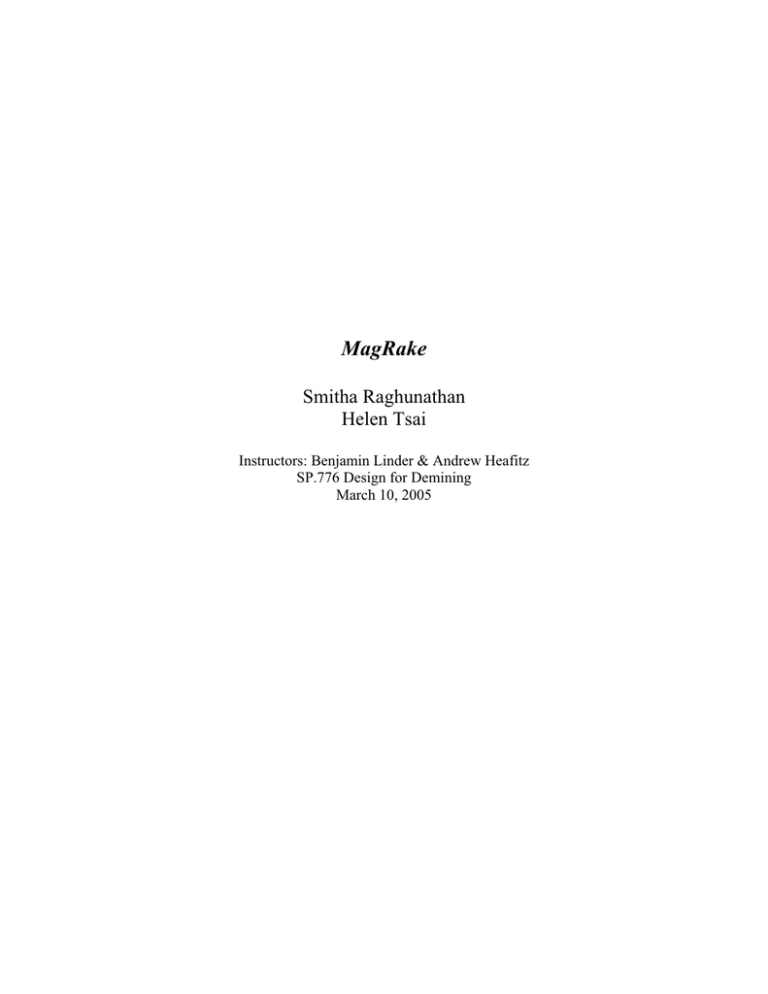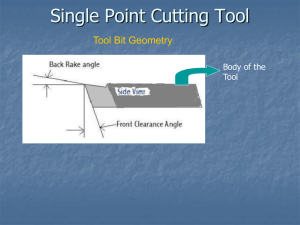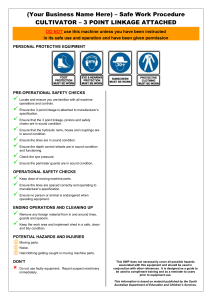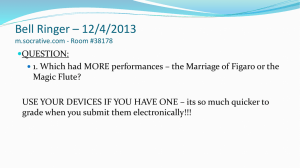Document 13596588
advertisement

MagRake Smitha Raghunathan Helen Tsai Instructors: Benjamin Linder & Andrew Heafitz SP.776 Design for Demining March 10, 2005 1.0 Introduction The MagRake is a tool that employs magnets to reduce the problem of ferrous fragments in demining areas. This is a major problem in several areas of the world dealing with landmine problems, and warrants the development of a tool that addresses this issue. The presence of ferrous fragments in areas of demining causes many false positives when using a metal detector; these force deminers to excavate the area carefully, treating the fragment as if it were a mine. This greatly increases demining time, as excavation becomes a time-consuming process when coupled with numerous frags per square meter. The tool developed over the course of this semester aims to eliminate ferrous frags from the demining area, thereby reducing the repetitions of excavation for non-mine material. A rake was chosen to be used in conjunction with magnets in order to unearth fragments so they could better be drawn to the magnet(s) on the tool. The main goal this semester was to justify the use of this tool, and determine characteristics of its design in order to make it worthwhile to use. This was important as the use of this tool involves the creation of an extra step in the SOP (Standard Operating Procedures) of the Demining Process. As change is not accepted readily by the established demining organizations, there needs to be clear-cut advantages to using this tool that will make the demining process noticeably better. 2.0 Design: Product & Model Creation 2.1 Model Design The purpose of the model was to determine whether or not the insertion of the MagRake tool into the SOP was feasible. This was an extremely important process in the work for this semester as since most of the demining industries are well established, and resistant to change without legitimate reason. Therefore, it was necessary to prove that using our product would cause a significant improvement in the demining process via the reduction of time. The model that we created was based on real figures from papers and experiments by Andy Smith and Bob Keeley. We detailed the various times it takes a deminer to accomplish their tasks. First regular demining procedures were examined and quantified: brush clearance, metal detecting, probing and excavating. Additionally, the change from metal the detection/probing method to an excavation based method was included in the model in the case of highly fragmented areas. Likewise, we wanted our model to depict the raking process and see if there is a clear region of use for the rake. We used estimated times from our experiment for this aspect of the model. Running the model for a series of different fragment concentrations and rake efficiencies led to the creation of a product with 50% rake efficiency. Appendix C contains the graphs and charts detailing the model. 2.2 Product Design The design of MagRake followed closely from the testing that is outlined in the proceeding section. The product implemented magnets, placed on the body of the rake so as to maximize their separation from the point of mine detonation (where the tips of the tines are located). Another feature was the flexibility of the tines, which were employed in order to better control the application of force to the ground. The final feature was the hand-held nature of the rake which was used in order to encourage a safer kneeling or squatting position and increase user control. As discussed in the Model Design section above, we determined that it was possible to create a 50% efficient rake as per our results to the tests we conducted (see Appendix D) 3.0 Testing: The Product and the Model 3.1 The Model 3.11 Experiment Setup Apart from the mechanical properties of our product, it also needed to be tested with the model in mind. This was necessary in order to see if the MagRake was capable of the efficiency the model predicted was required in order for it to be a viable product in the demining marketplace. From the model, we concluded that a rake with 50% efficiency was needed to make the project worthwhile. Therefore, our first step was to make sure we could do so before continuing with the project. It is important to note that Andy Smith’s magnetic rake is 88% efficient (a rake we based the idea of our product off). However, unlike Andy, we decided to implement a handheld rake. 1 We tested for 50% efficiency for two different scenarios (pure sand and a mix of sand, mulch, and water). Fragments were placed at three different depths; the number of frags at each depth, and their location on an 80cm by 20cm grid were determined using a random number generator (www.random.org). 3.12 Experimental Results The resulting averaged times for the experiments were: pass without picking up fragments = 35 seconds, and time to remove fragments = 8-12 seconds. Apart from these direct results from the testing, including the charts shown in Appendix C, there were two situations that were illuminated during the testing: cleaning of frags from the rake and depth of penetration of the tines. The deminer cleared the metal fragments off the rake when she noticed them; but at times she failed to do so. Therefore, some fragments were lost when she proceeded to rake with metal still on the tines. This situation points out the advantages of some autonomous cleaning system that ensures a fast, thorough and rapid clearance of fragments from the rake between every cycle. The second issue regarded the size of the tips of the tines. The 2.5 inch tips used in our set of experiments caused an unnecessarily large separation between the magnet and the ground. This resulted in a greater degree of passes over the same ground before the magnet was close enough to attract fragments (due to the exponential decay of a magnet’s strength with distance). This situation was aggravated by the harder ground of the second trial, which resulted in a total of 11 (as opposed to the 4 in pure sand) passes in order to pick up a significant number of fragments. 3.2 MagRake There were several possible designs considered throughout the course of the semester. These were based on choices between several key factors of the product: placement of the magnet(s), stiffness of rake tines and position of user. Early testing was done to see if strategic placement of magnets could magnetize the rake tines. Upon experimentation, it was determined that this was not possible to a degree that would actually aid in the collection of ferrous fragments, and the idea was abandoned. After that issue was addressed, next was the consideration of safety. One of the major concerns of this project is safety, and therefore consideration was give to the issue of magnets in a landmine blast. It was determined that magnets should be placed on the body of the rake as opposed to directly on the tines, thereby separating them from a possible blast to some extent. Appendix A contains pictures from the testing of magnet placement on MagRake. Safety was also an issue of consideration when looking at the stiffness of the rake tines. This was of concern because stiffness directly correlates to the amount of force that is put on the ground. By using a rake with more flexible tines, an upper threshold can be somewhat maintained. This is possible because the tines absorb some of the force the user imparts in a similar manner as a spring. Therefore, for the user to push on the ground with a certain force, they must first deflect the tines (springs) a certain amount. The spring equation of F = kx is translated into F = (stiffness of rake tines) (bending of tines) for a rake. This situation makes it more difficult to push on the ground without noticing, as the tines will bend significantly. This was determined to be a favorable situation compared to infinitely stiff tines, as that is more likely to cause unfavorable pressures to be exerted on the ground. The final major consideration when designing this product was how the user would be situated when using it. MagRake could be used either standing up (using a full-sized rake) or kneeling/squatting (using a hand rake). This issue was decided by looking at: safety during a blast, user comfort and ease of tool use. Safety was facilitated by a lower user stance, owing to the spreading of the blast perimeter with increased distance from origin (increase in height). User comfort and ease of tool use were not looked at in great detail and need to be tested more. Appendix B contains pictures from the testing of user stance for MagRake. 4.0 Manufacturing The prototypes for this semester’s work were made mostly by using pre-existing rakes, and modifying them in some manner or another. The main modifications that were made were a reduction in rake-head size and the number of tines. Additionally, magnets were attached to the rake by simple electrical tape coupled with the attraction between the ferrous tines and the magnet. 2 55.0 Future Work There are three major issues that need to be addressed as this project continues: limitation to the amount of force the rake places on the ground, the interaction with the mines and magnets, and the nature of the raking motion (standing or kneeling). The force the rake places on the ground is a key issue to the success of the MagRake. A delicate balance needs to be maintained between force the rake places on the ground, and the amount of frags that it picks up. The force needs to be high in order to penetrate the ground and pick up as many frags as possible with the least passes as possible (limiting time); but it also needs to be low enough in order to not set off mines. The second major issue is the interaction between magnets and mines. One of the major considerations in the design of any demining product is its reaction to a blast from a landmine. The ideal situation is for the tool to bend and deform as opposed to shatter. The concern with magnets is their ceramic construction. This composition results in a shattering during a mine blast, possibly causing great harm to a deminer. One promising solution is a separation between the tines touching the ground and the placement of the magnets. If this distance is set correctly, shattering during a blast may be avoided. Another solution would be a protective casing around the magnets. These situations should be explored in order to determine whether or not they are viable in the demining industry. The final issue is the stance of the user while using our product. The only issue that was looked at thoroughly was user safety during a blast. While this issue clearly led to a kneeling or squatting stance, the other two issues were not explored in enough detail to point in one direction or another. User comfort and ease of use tests were run on a very small pool of individuals, and needs to be expanded to get more reliable results. In addition to these fundamental problems, there are also improvements that can be made to the tests conducted. First is to test a greater variety of ground types and range of harnesses. This will help determine what environments MagRake works best in. Second is the environment for testing. Limitations were encountered due to the size and shape of the container used to place the experimentally simulated ground and fragments. A deeper, wider container, causing no impedance to user motion would create more realistic results. 3 Appendices Appendix A: Magnet Placement 4 Appendix B – Stance using rake 5 Appendix C – graphs for model design and sources for data % improvement with MagRake 70 60 10 frags/m2 50 3 frags/m2 40 50 frags/m2 30 20 10 0 0 10 20 30 40 50 60 70 80 -10 -20 Rake Efficiency (%) Figure 1: Rake efficiency vs. percent improvement 70 50% MagRake Efficiency % improvement from current situation 60 25% MagRake Efficiency 50 75% MagRake Eficiency 40 30 20 10 0 0 10 20 30 40 50 60 -10 -20 Time (min) Figure 2: Time vs. percent improvement with different efficiencies in MagRake Table 1: Data source for numbers in model Data on Model Source Conventional Demining Cycle for 20cm Average Advance/meter with Standard Metal Detecting Time to investigate signal 20 - 30 min Bob 47-60 min Andy pg 21 pg 23 1-21 min Andy pg 44 - 54 Average Advance/meter with Magnetic rake (Region Flailed beforehand) 18-22 min Andy pg 26 Trench Making Average Advance/meter with Excavation (without Trench making factored in) 25-28 min Andy pg 32 44 min Andy pg 32 * Bob Keeley "Understanding Landmines and Mine Action" = Bob * Andy Smith's "Comparatative trials of manual mine clearance techniques in Mozambique, 2004" = Andy 6 Appendix D – Model Testing Results Surface Fragments Fragments Burried at 1 cm 20 Fragments Burried at 2 cm Verticle Placement (cm) 18 16 14 12 10 8 6 4 2 0 0 10 20 30 40 50 60 70 80 Horizontal Placement (cm) Figure 3: Location of buried fragments for all testing Figure 4: Ground type I results [sand] – circles indicate fragments picked up and numbers indicate what pass 7 Table 2: Results from ground type I testing [sand] 1 2 3 4 Pass 22 17 15 18 5 25 11 6 8 20 12 Fragment Picked Up 30 19 10 28 1:07 1:53 :52 1:08 Time/Pass 9/9 Surface Frags Picked up 8/9 Surface Frags Picked up on First Pass 6/7 Frags Buried at 1cm Picked up 0/14 Frags Buried at 2cm Picked up Figure 5: Ground type II testing [sand, mulch & water] - circles indicate fragments picked up and numbers indicate what pass 8 Table 3: Results from ground type II testing [sand, mulch & water] 1 2 3 4 5 6 Pass 20 5 Fragment Picked Up 30 28 19 :34 :41 :41 :34 :44 :36 Time/Pass 9 21 :30 10 11 12 13 14 3 16 1 13 2 Fragment Picked Up 17 23 11 27 25 8 10 15 :28 :41 :55 :40 :40 :42 :36 Time/Pass 7/9 Surface Frags Picked up * At first we stopped after 4 passes and we took out a surface fragment that we could see, but later resumed the trial 5/7 Frags Buried at 1cm Picked up 7/14 Frags Buried at 2 cm picked up 19/30 Total Frags picked up Pass 8 7 Figure 6: Time to remove metal fragments *Shaded Teal Area = Region Where Rake Would Be Used 9 MIT OpenCourseWare http://ocw.mit.edu EC.S06 Design for Demining Spring 2007 For information about citing these materials or our Terms of Use, visit: http://ocw.mit.edu/terms.





